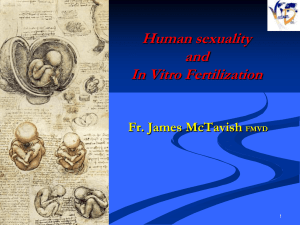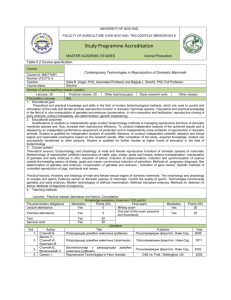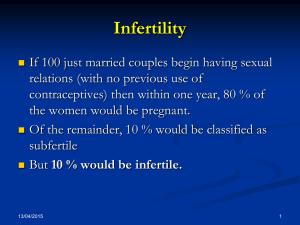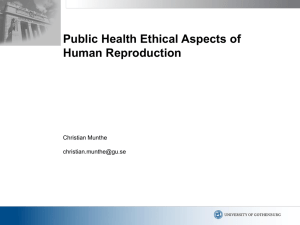Word - Saint Mary`s Press
advertisement
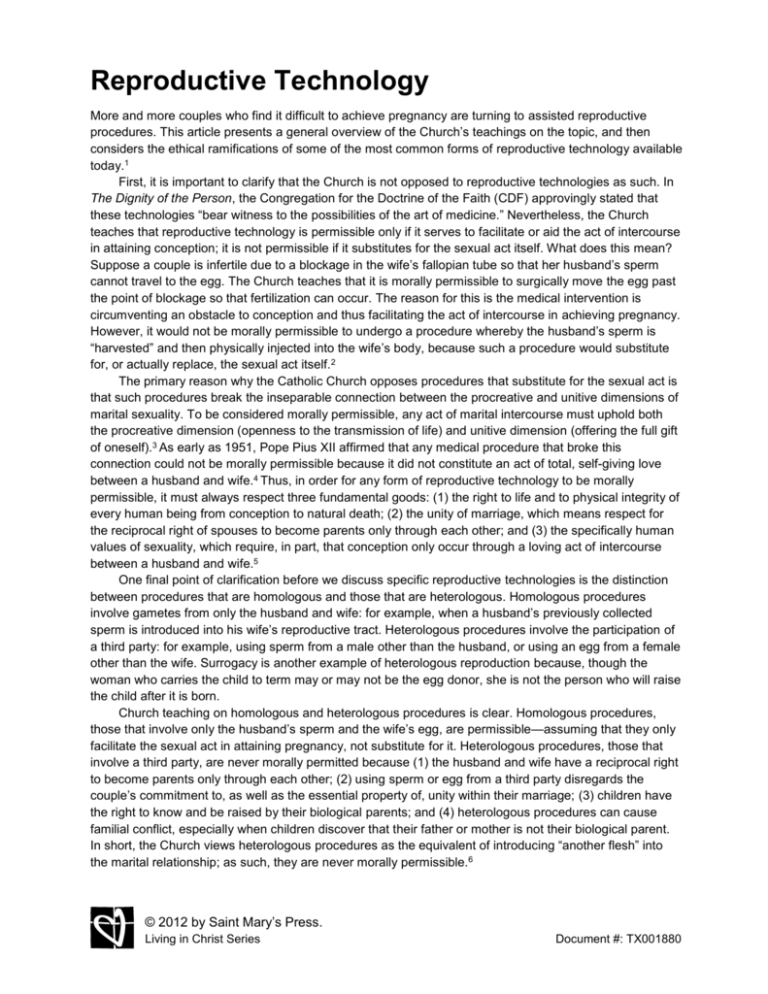
Reproductive Technology More and more couples who find it difficult to achieve pregnancy are turning to assisted reproductive procedures. This article presents a general overview of the Church’s teachings on the topic, and then considers the ethical ramifications of some of the most common forms of reproductive technology available today.1 First, it is important to clarify that the Church is not opposed to reproductive technologies as such. In The Dignity of the Person, the Congregation for the Doctrine of the Faith (CDF) approvingly stated that these technologies “bear witness to the possibilities of the art of medicine.” Nevertheless, the Church teaches that reproductive technology is permissible only if it serves to facilitate or aid the act of intercourse in attaining conception; it is not permissible if it substitutes for the sexual act itself. What does this mean? Suppose a couple is infertile due to a blockage in the wife’s fallopian tube so that her husband’s sperm cannot travel to the egg. The Church teaches that it is morally permissible to surgically move the egg past the point of blockage so that fertilization can occur. The reason for this is the medical intervention is circumventing an obstacle to conception and thus facilitating the act of intercourse in achieving pregnancy. However, it would not be morally permissible to undergo a procedure whereby the husband’s sperm is “harvested” and then physically injected into the wife’s body, because such a procedure would substitute for, or actually replace, the sexual act itself.2 The primary reason why the Catholic Church opposes procedures that substitute for the sexual act is that such procedures break the inseparable connection between the procreative and unitive dimensions of marital sexuality. To be considered morally permissible, any act of marital intercourse must uphold both the procreative dimension (openness to the transmission of life) and unitive dimension (offering the full gift of oneself).3 As early as 1951, Pope Pius XII affirmed that any medical procedure that broke this connection could not be morally permissible because it did not constitute an act of total, self-giving love between a husband and wife.4 Thus, in order for any form of reproductive technology to be morally permissible, it must always respect three fundamental goods: (1) the right to life and to physical integrity of every human being from conception to natural death; (2) the unity of marriage, which means respect for the reciprocal right of spouses to become parents only through each other; and (3) the specifically human values of sexuality, which require, in part, that conception only occur through a loving act of intercourse between a husband and wife.5 One final point of clarification before we discuss specific reproductive technologies is the distinction between procedures that are homologous and those that are heterologous. Homologous procedures involve gametes from only the husband and wife: for example, when a husband’s previously collected sperm is introduced into his wife’s reproductive tract. Heterologous procedures involve the participation of a third party: for example, using sperm from a male other than the husband, or using an egg from a female other than the wife. Surrogacy is another example of heterologous reproduction because, though the woman who carries the child to term may or may not be the egg donor, she is not the person who will raise the child after it is born. Church teaching on homologous and heterologous procedures is clear. Homologous procedures, those that involve only the husband’s sperm and the wife’s egg, are permissible—assuming that they only facilitate the sexual act in attaining pregnancy, not substitute for it. Heterologous procedures, those that involve a third party, are never morally permitted because (1) the husband and wife have a reciprocal right to become parents only through each other; (2) using sperm or egg from a third party disregards the couple’s commitment to, as well as the essential property of, unity within their marriage; (3) children have the right to know and be raised by their biological parents; and (4) heterologous procedures can cause familial conflict, especially when children discover that their father or mother is not their biological parent. In short, the Church views heterologous procedures as the equivalent of introducing “another flesh” into the marital relationship; as such, they are never morally permissible.6 © 2012 by Saint Mary’s Press. Living in Christ Series Document #: TX001880 Reproductive Technology Page | 2 In Vitro Fertilization (IVF) IVF is one of the most popular reproductive technologies today. Its success rate, however, is relatively low: roughly 37 percent for women age thirty-five and younger, regressing to 11 percent for women in their early 40s.7 At $12,000–$15,000 for a single cycle, IVF is also expensive. In this procedure, an egg is removed from the mother’s body and combined in a Petri dish with sperm from the donor father. If fertilization occurs, the resulting embryo is transferred to the woman’s uterus where, it is hoped, it will develop into a healthy child. IVF can be either homologous or heterologous. It is homologous when only the wife’s ovum and the husband’s sperm are used, and the resulting embryo is transferred to the wife’s uterus. It is heterologous when either sperm or egg is donated by a third party, or when the resulting embryo is transferred to a surrogate who then carries the child to term.8 The Magisterium has consistently opposed all forms of IVF, a teaching that was most recently reiterated by the CDF in The Dignity of the Person (2008). Heterologous IVF is opposed because it introduces a third party into the procreative process, and because it deprives the child of the right to be conceived, gestated, and born of its biological parents. Homologous IVF is opposed because, as fertilization takes place outside the body, it breaks the inseparable connection between the procreative and unitive dimensions of marital sexuality. In addition, because the embryo can be viewed as the product of medical technology rather than as the fruit of a loving act between husband and wife, IVF contributes to the “domination of technology over the origin and destiny of the human person.”9 For these reasons, the Catholic Church teaches that IVF is intrinsically wrong and that no good motive on the part of the couple can make it permissible. The Magisterium’s opposition to IVF has caused considerable controversy within the Church, and many have critically questioned its teaching. Some ethicists disagree with the Church’s teaching that the child created from IVF is the product of technology, arguing instead that parents who have battled infertility view their child as a gift, even a miracle, from God. Others argue that the Church’s “domination of technology” language fails to consider that IVF and related medical interventions can actually serve humanity. Still others maintain that though the ideal is to uphold the procreative and unitive dimensions of marital sexuality, their separation is not necessarily evil. 10 Space does not permit a detailed treatment of these objections nor a comprehensive summary of this important and ongoing debate. We simply want to state that whether or not one believes IVF to be intrinsically evil, the procedure does raise a number of important ethical concerns. First, in order to increase the odds of achieving at least one fertilized embryo, the woman is prescribed drugs that cause her to produce multiple eggs (hyper-ovulation). Unfortunately, these drugs are known to cause ovarian hyper stimulation syndrome, infection, high blood pressure, bleeding, and damage to the bowel and bladder.11 Because of these side effects, many question whether their use is in the best long-term health interests of the mother. Second, there is the issue of multiple births. IVF pregnancies are ten times more likely to produce multiple births than are “natural” pregnancies, and the Centers for Disease Control reports that from 2000– 2007 approximately 37 percent of all pregnancies resulting from assisted reproductive procedures produced multiples.12 Multiple births pose significant health risks including higher rates of tubal (ectopic) pregnancy, premature and underweight children, and increased probability of long-term handicap. One must also consider the monetary costs that multiple pregnancies impose on society. In 2005, the average cost to deliver a single child was approximately $10,000; for twins it rose to $100,000, and for triplets and other multiples it was even higher. IVF and other technologies contribute to these rising costs. In fact, since the year 2000 alone, American taxpayers have paid more than $650 million in medical costs for multiple-birth pregnancies resulting from assisted reproductive procedures. 13 © 2012 by Saint Mary’s Press. Living in Christ Series Document #: TX001880 Reproductive Technology Page | 3 Third, in order to increase the chances of achieving pregnancy, more than one egg is fertilized at a time. Fertility clinics create numerous embryos and implant the ones they believe are most viable. The remaining or “leftover” embryos are then either frozen or discarded. The reason clinics freeze embryos is to cut costs for potential parents; if the first attempt at IVF does not produce a pregnancy, there are backup or spare embryos available so that they may try again without having to repeat the entire process. The Church opposes the freezing of human embryos for a number of reasons. One reason is philosophical. Human beings, like all creatures, exist in time and space. Maintaining nascent life in a frozen, suspended state—one that arrests its normal development—is a particularly egregious offense against the dignity of a fellow human being. Another reason is theological. As stated earlier, the Church maintains that as the embryo is a human life created in the image and likeness of God, it must be given “the unconditional respect owed to every human being at every moment of his or her existence.”14 Freezing embryos hardly respects their dignity, as it is not something one would ever think of doing to another living person. A third reason is more practical. What should be done with all the leftover embryos? Sometimes pregnancy is achieved on the first IVF cycle and the couple decides that their family is complete. They no longer need their extra embryos so they simply abandon them at the clinic. Today there are more than 400,000 such embryos in the United States alone. What do we do with them? Discarding embryos also raises a number of ethical challenges. Often when couples decide that their family is complete, they choose to have their spare embryos destroyed. This can happen directly, such as when the couple instructs the clinic to remove the embryos from cold storage, thaw them out, and then dispose of them in biohazard waste. Discarding can also happen indirectly, such as when couples stop paying the fertility clinic’s storage fees. The problem with discarding embryos, according to Church teaching, is that it is the moral equivalent of abortion. Fertility clinics, as well as the biological parents, are directly and intentionally ending the existence of these embryos through their actions, embryos that the Church defines as human life and worthy of both dignity and respect. Some people will argue that instead of discarding the embryos or maintaining them in an indefinite suspended state, they should be donated to scientific research. Today, this usually means stem cell research. We will speak more about this research in the next section, but the primary moral issue is that when stem cells are extracted from a human embryo, the embryo dies. This too is the moral equivalent of abortion. A final ethical difficulty with IVF concerns a process euphemistically termed “selective reduction.” In order to maximize the odds of achieving pregnancy, fertility clinics implant numerous embryos into the mother in the hope that one or maybe two of them will develop into a child. In some cases three or four embryos (occasionally even more) succeed and the parents are then faced with the prospect of multiple fetuses. To avoid the costs and complications associated with multiple births, doctors will often “selectively reduce” a multiple pregnancy by identifying the fetuses they believe are most viable and destroying the rest within the mother’s womb. This procedure constitutes a direct and intentional abortion and, according to Church teaching, is an intrinsic evil. © 2012 by Saint Mary’s Press. Living in Christ Series Document #: TX001880 Reproductive Technology Page | 4 Endnotes 1. For concise descriptions of these procedures, see Sharon Begley, “The Baby,” Newsweek (September 4, 1995): 38–41, 43–47. 2. Dignity of the Person, 12; see also Gift of Life, II, number 7. For further discussion on permissible and impermissible methods of assisted fertilization, see William May, Catholic Bioethics and the Gift of Human Life (Huntington, IN: Our Sunday Visitor, 2000), 87–94. 3. See Dignity of the Person, number 6. 4. Pope Pius XII, Discourse to the Italian Catholic Union of Midwives, October 29, 1951 (Acta Apostolicae Sedis, 1951), 850. 5. Dignity of the Person, number 12. See also Gift of Life, Introduction, number 3; and II, numbers 1–2, 4. 6. Gift of Life, II, numbers 1–2. 7. Figures are taken from the U.S. Department of Health and Human Services, Centers for Disease Control, Assisted Reproductive Technology Report: National Summary (2000–2007), available online at apps.nccd.cdc.gov/ART/NSR.aspx?SelectedYear=2007. 8. For more information on IVF and other assisted reproductive technologies, see the American Society for Reproductive Medicine, Assisted Reproductive Technologies: A Guide to Patients (2008), at www.asrm.org/Patients/patientbooklets/ART.pdf. 9. Dignity of the Person, numbers 14–17. See also Gift of Life, II, numbers 4–5. 10. These arguments are summarized in Devine, Good Care, Painful Choices, 116–17. 11. See Assisted Reproductive Technologies, 12–14; and Scott Gilbert et al., Bioethics and the New Embryology: Springboards for Debate (Sunderland, MA: Sinaur, 2005), 73–74. 12. Centers for Disease Control, Assisted Reproductive Technology Report (2000–2007). 13. Gilbert et al., Bioethics and the New Embryology, 74–76. 14. Dignity of the Person, number 10. (This article is closely adapted from Catholic Ethics in Today’s World, revised edition, by Jozef D. Zalot and Benedict Guevin, OSB [Winona, MN: Anselm Academic, 2011]. Copyright © 2008, 2001 by Jozef D. Zalot and Benedict Guevin. Used with permission of Anselm Academic.) © 2012 by Saint Mary’s Press. Living in Christ Series Document #: TX001880


